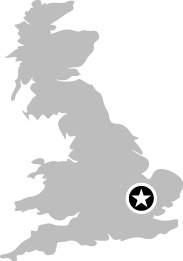047
Gonville and Caius College, Cambridge, England
 52° 12′ 21.4″ N, 0° 7′ 3.34″ E
52° 12′ 21.4″ N, 0° 7′ 3.34″ E
![]()
Stained-Glass Scientists
The first thing you need to know about Gonville and Caius College is how to pronounce it. Gonville is easy, no surprises there. But Caius is another matter. John Keys was the second founder of the college; in 1529 he entered what was then Gonville Hall at just 18 years old. He later became a Fellow of the college, and finally Master (after having spent a chunk of his own fortune restoring it).
Along the way he Latinized his last name, turning Keys into Caius without changing the pronunciation. Thus, Gonville and Caius is pronounced “Gonville and Keys”; within Cambridge the college is usually referred to as simply Caius.
Caius has an illustrious list of alumni. They include William Harvey (who discovered blood circulation), George Green (mathematician), John Venn (who popularized the Venn diagram), Charles Sherrington (Nobel Prize–winning neurophysiologist), R. A. Fisher (probably the greatest statistician ever), Sir James Chadwick (who discovered the neutron), Francis Crick (DNA; see Chapter 71), and Stephen Hawking.
Six of these alumni are honored with stained-glass windows representing their greatest contribution in the college Hall where students and Fellows eat.
John Venn’s famous Venn diagram (Figure 47-1) is used to show intersecting sets of items and is represented by three colored circles. Each circle overlaps the other two, and all three overlap in the middle with appropriate changes in color.
R. A. Fisher was not only a great statistician, but also a celebrated geneticist and evolutionary biologist. His window shows a 7×7 Latin Square that uses colors instead of the typical numbers (Figure 47-2). A Latin Square is a square grid in which numbers are placed so that each number only appears once per row and column. (Many people will recognize this as a sort of Sudoku.)

Figure 47-1. Venn’s window diagram; courtesy of Derek Ingram,
Gonville and Caius College

Figure 47-2. Fisher’s Latin Square;
courtesy of Derek Ingram, Gonville and Caius College
Fisher used Latin Squares in statistical analysis and in particular in agriculture. By dividing a field into a square grid, it’s possible, for example, to try out seven different fertilizers using a 7×7 Latin Square. By associating one fertilizer with each of the seven different numbered squares, it is possible to use the square to eliminate differences in soil, drainage, sunlight, etc. because each fertilizer will be applied once per row and column.
Francis Crick’s window shows the structure of DNA. When the window was installed, Crick insisted that it not be visible from the outside at night so that the DNA would only be seen coiling in the right direction.
George Green’s window shows something that at first glance looks like it might be bacteria, but it’s in fact a representation of Green’s Theorem (which you’ll be familiar with only if you studied calculus to a high level). Green’s Theorem shows how an integration over an enclosed area (the bacteria-like shape in the window) can be turned into an integration over just the line that forms the shape’s boundary. Although this may seem totally abstract, it is used directly in the planimeter (see page 67), which can calculate the area of a shape on a graph or map just by tracing around its edge.
Sir James Chadwick’s window shows an alpha particle (a helium nucleus) hitting a beryllium atom and causing the emission of a neutron (and creation of a carbon atom).
Finally, there’s Charles Sherrington’s window, which shows “two excitatory afferents with their fields of supraliminal effect in a motor neuron pool of a muscle.” It looks like some sort of plant, but it actually shows the motor neurons that control muscle movements. Sherrington won the Nobel Prize in 1932 (with Edgar Douglas Adrian) for discovering the function of neurons.
Gonville and Caius is open to the public (and free of charge), but unfortunately the public does not have access to the Hall where the windows are installed. To see them, you’ll have to make friends with a Cambridge University student who’s willing to accompany you, or make do with a virtual tour.
The college is right next to Trinity College, where Newton lived (see Chapter 69), and a short walk from the Eagle Pub, where Crick and Watson announced the “secret of life” (see Chapter 71).
Practical Information
The website of Gonville and Caius College is at http://www.cai.cam.ac.uk/, and you can take an interactive tour at http://www.cai.cam.ac.uk/map1.php.


